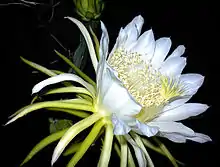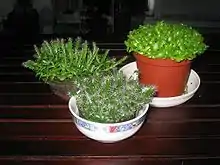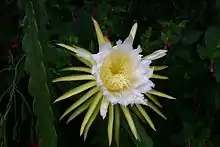Hylocereus
Hylocereus is a genus of epiphytic cacti, often referred to as night-blooming cactus (though the term is also used for many other cacti). Several species have large edible fruits, which are known as pitahayas or dragonfruits. Whether Hylocereus is a distinct genus is uncertain as of July 2013.
| Hylocereus | |
|---|---|
 | |
| Hylocereus undatus | |
| Scientific classification | |
| Kingdom: | Plantae |
| Clade: | Tracheophytes |
| Clade: | Angiosperms |
| Clade: | Eudicots |
| Order: | Caryophyllales |
| Family: | Cactaceae |
| Subfamily: | Cactoideae |
| Tribe: | Hylocereeae |
| Genus: | Hylocereus (A.Berger) Britton & Rose |
| Type species | |
| Hylocereus triangularis | |
| Species | |
|
See text | |
Description

The species of the genus Hylocereus grow hanging, climbing or epiphytic. They are freely branched, shrubby plants that form aerial roots and become very large with a height of 10 m or more. They are green, often glaucous shoots are usually terete or triangular.[1]
Taxonomy
In the classification of the International Cactaceae Systematics Group of the International Organization for Succulent Plant Study, the genus Hylocereus is one of the six genera of the tribe Hylocereeae. In this classification, the genus Wilmattea Britton & Rose is included in Hylocereus.[2] A 2011 study of the molecular phylogeny of the Cactaceae concluded that neither the tribe nor the genus was monophyletic (i.e. neither comprised all the descendants of a common ancestor). Two species of Hylocereus formed a clade with two species of Selenicereus, suggesting that the genera were not distinct.[3]
Species
Species as of 2019:[4]
| Flowers | Fruit | Scientific name | Description | Distribution |
|---|---|---|---|---|
| Hylocereus calcaratus (F.A.C. Weber) Britton & Rose | Stems soft, green with distinctly lobed stems. Flowers 35–37 cm long, 20–30 cm wide. | Costa Rica. | ||
 |  | Hylocereus costaricensis (F.A.C. Weber) Britton & Rose (incl H. polyrhizus of gardens) | Stems waxy-white without horny margins. Flowers ca. 30 cm long with large bracts, usually with purple margins. Fruit red with purple pulp. | Costa Rica, Nicaragua and Panama. |
| Hylocereus escuintlensis Kimnach | Stems green not glaucous, brown-margined. Flowers 28–31 cm long, 24–36 cm wide. | Guatemala | ||
 | .jpg.webp) | Hylocereus megalanthus (K. Schum. ex Vaupel) Ralf Bauer | Stems green, slender without horny margins. Flowers 30–38 cm long with large flattened tubercles and small bracts. Flowers similar to Selenicereus. Fruit yellow. | Venezuela to Peru, including Colombia, Bolivia, Ecuador |
 |  | Hylocereus monacanthus (Lem.) Britton & Rose (incl. H. lemairei) | Stems gray-green without horny margins. Flowers ca 30 cm long, petals white, tinged pinkish near base or entirely pink. Tube with distant bracts. Stigma lobes usually forked. Fruit red with purple pulp. | Costa Rica to N South America. |
| Hylocereus minutiflorus Britton & Rose | Stems green. Flowers with rigid spines at base of flower, 5 cm long, 8–9 cm wide, white. | Guatemala, Honduras. | ||
| Hylocereus ocamponis (Salm-Dyck) Britton & Rose (incl. Hylocereus guatemalense, Hylocereus purpursii) | Stems white-waxy, margins horny, spines needle-like, to 12 mm long. Flowers 25–32 cm long with white inner petals. Bracts overlapping, with purple margins. | Mexico and Guatemala. | ||
_Werdermann.JPG.webp) | Hylocereus setaceus (Salm-Dyck ex DC.) Ralf Bauer | Stems green without horny margins, rather spiny. Flowers 19–22 cm with small tubercles and bracts. Flowers similar to Selenicereus. Fruit red. | Argentina, Bolivia, Brazil, and Paraguay | |
| Hylocereus stenopterus (F.A.C. Weber) Britton & Rose | Stems thin, soft, green. Flowers 9–10 cm long, 13–15 cm wide, tube short, tepals purplish red. | Costa Rica. | ||
 | Hylocereus triangularis (L.) Britton & Rose (incl. Hylocereus cubensis) | Stems green without horny margins, slender. Flowers ca. 20 cm long, base with wide overlapping scales. | Cuba, Haiti, Dominican Republic, Jamaica. | |
| Hylocereus trigonus (Haw.) Saff. (incl. Hylocereus napoleonis, Hylocereus antiguensis) | Stems green without horny margins. Flowers ca. 22 cm long, 21 cm wide, base with small, narrow, widely spaced scales, sometimes spiny. Fruit red. | West Indies (Puerto Rico south to Grenada). | ||
 |  | Hylocereus undatus (Haw.) Britton & Rose | Stems green, margins undulate and horny. Flowers 25–30 cm long, white with green outer tepals and bracts. Fruit red with white pulp. | Native habitat unknown and maybe of hybrid origin. |
See also
| Wikispecies has information related to Hylocereus. |
- Epiphyllum – another cactus genus yielding edible fruits
References
- "On-line Guide to the positive identification of Members of the Cactus Family". On-line Guide to the positive identification of Members of the Cactus Family. Retrieved 2019-07-25.
- Anderson, Edward F. (2001), The Cactus Family, Pentland, Oregon: Timber Press, ISBN 978-0-88192-498-5, p. 101
- Bárcenas, Rolando T.; Yesson, Chris & Hawkins, Julie A. (2011), "Molecular systematics of the Cactaceae", Cladistics, 27 (5): 470–489, doi:10.1111/j.1096-0031.2011.00350.x
- "Search results". The Plant List. 2012-03-23. Retrieved 2019-07-24.